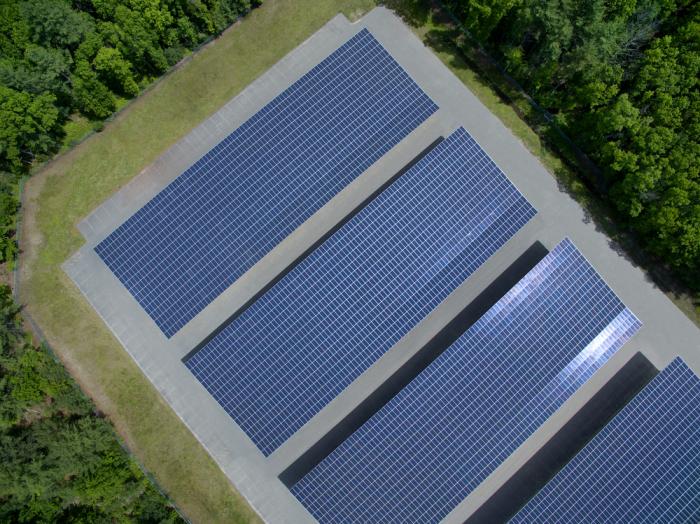
Editor’s Note: In February 2022, SunPower’s Commercial and Industrial Solutions business was acquired by TotalEnergies. Learn more about sustainability options for these industries.
While the cost of solar power for business continues to fall, your company may still be looking for ways to reduce the near-term financial impact of your solar investment. In fact, there are a number of considerations to keep in mind as you weigh the front-end cost of a commercial solar system against the long-term savings it could bring your organization.
As you’ll see, commercial solar tax credits are just the tip of the iceberg when it comes to gauging the actual costs of investing in solar power for business. Here are six factors you may not have thought about—considerations that could save your business tens or even hundreds of thousands of dollars per year. Be sure to click through the links in each section for more detail on each of these topics.
1. Earning credit for going solar: The solar Investment Tax Credit (ITC)
First created in 2006 (and extended in 2015), the solar Investment Tax Credit (ITC) is a federal policy designed to encourage the deployment of solar energy in the U.S. by offsetting the cost of commercial solar systems. The solar ITC allows organizations that invest in qualifying solar projects to receive a credit against the income taxes they’d otherwise owe the federal government.
The solar ITC is equal to a percentage of the amount invested in an eligible installation. Note, however, that the ITC steps down and is currently a 26% tax credit for 2020, dropping to 22% in 2021 and 10% after 2021. So the sooner you act, the more you can save.
2. Getting paid for giving back: Net metering
Net energy metering (NEM) is essentially a billing arrangement that allows organizations generating their own electricity to deliver unused energy back to the grid—and be credited at the retail energy rate. In most cases, these credits are applied to your monthly electric utility bill or rolled over month-to-month until they’re used up. You can even be compensated for any excess energy you generate. It can be a highly effective way to reduce the overall cost of solar panels for business.
It’s important to know that NEM policies can vary widely, depending on your utility and state. So be sure to do your homework to see if net metering is currently an option in your state. The Database of State Incentives for Renewables & Efficiency (DSIRE), which is funded by the U.S. Department of Energy, is a great place to find out.
3. Earning cash for energy produced: Solar Renewable Energy Credits
Considered as the currency of renewable energy, Solar Renewable Energy Credits (SRECs) allow organizations to track—and potentially profit from—the amount of clean, renewable energy produced by a commercial solar system. The more electricity produced, the more SRECs created. Many organizations choose to sell these credits to help offset the cost of installing commercial solar panels.
While SRECs can be traded directly, most organizations choose to use a third-party aggregator to sell their SRECs. As with NEM, SREC policies and markets vary widely by state and are not in place everywhere. Check DSIRE to find out whether these innovative credits are available to you.
4. Knowing what costs what, and when: Utility rate structure
Like most businesses, you probably pay two types of charges on your monthly utility bill: 1) usage charges (based on actual kilowatt-hours used), which can vary by time of day; and 2) demand charges, which are calculated based on your maximum kilowatt usage in a month (typically measured in 15-minute intervals).
Knowing how your utility structures these rates—and their impact on your monthly energy costs—could save you thousands of dollars every month. Getting those details will help you decide how to better manage your usage and whether investing in solutions like commercial solar and solar battery storage (see below) may make financial sense.
5. Reducing costs using the energy you’ve stored: Solar battery storage
An ever-growing number of businesses are taking a closer look at the potential of battery storage to lower their monthly energy bills, especially when combined with a commercial solar system. These refrigerator-sized batteries can offer a highly effective way to reduce demand charges by discharging their stored energy when needed to offset spikes in demand—potentially leading to substantial savings.
Battery storage systems can be purchased outright or leased from your solar provider, which helps eliminate upfront and ongoing maintenance costs. Combined solar and battery storage systems qualify for the solar ITC, and there may also be state rebates available with the purchase or lease of a storage system. Ask your provider or an independent energy consultant to analyze your load profile. They can help you evaluate whether solar energy storage is a good fit for your business.
6. Taking advantage of policies and rebates near you: State and local incentives
Promoting the growth and proliferation of clean, sustainable energy in business isn’t just a federal interest—many state and local governments offer support, rebates and other incentives. And that can mean additional ways to offset the cost of installing commercial solar panels.
As previously mentioned, the Database of State Incentives for Renewables & Efficiency is a great site to find federal, state and local renewable energy initiatives—including solar—in your area. Search by city, state or ZIP code for the latest policy and incentive information—and check their Other Resources page for links to state and local clean energy organizations that could provide even more information and money-saving tips.
As you’ve seen, there are a number of innovative ways to help offset and reduce the cost of solar power for business. All it really takes is a bit of time, a little research and a willingness to ask the right questions of your commercial solar provider and utility company. Doing so could mean significant savings for your business in both the short term (with the help of incentives like the commercial solar Investment Tax Credit) and the long term (with solar energy savings and the help of battery storage to reduce periods of peak demand).

